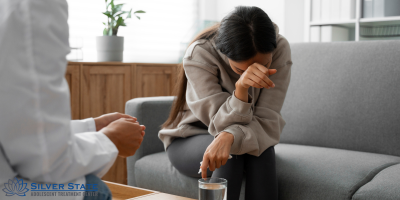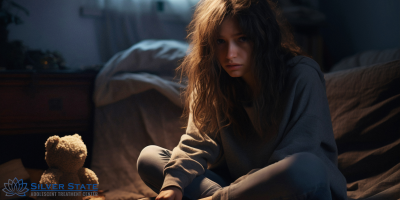How Teen Anxiety Treatment Helps with Social Media Stress and Online Comparison

Table of Contents
Key Takeaways
-
Teenagers can feel more anxious, compare themselves to others, and experience social pressure when using social media.
-
Individual therapy, teen group therapy, and trauma-informed techniques all work together to make treatment work.
-
Teen meditation therapy and trauma, and PTSD treatment are two examples of techniques that help people control their emotions.
-
Fighting isolation is essential for LGBTQIA+ healing because it builds community and strength.
-
A holistic anxiety treatment method helps kids deal with stress from technology and boost their self-esteem.
Introduction
Teenagers often feel bad about themselves, feel alone, or experience anxiety when they see edited highlights on social media. When scrolling through seemingly perfect lives becomes a daily habit, it can intensify feelings of insecurity, leading to emotional distress that demands professional attention. This is where teen anxiety treatment plays a crucial role. Effective treatment for adolescent mental health doesn’t just address surface-level symptoms—it explores the more profound impact of online comparison and digital overstimulation.
Teen group therapy, mindfulness, and trauma-informed programs are just a few examples of specialized therapies that can help young people regain their sense of self-worth and emotional equilibrium. Let’s explore how personalized interventions can help children navigate the emotional challenges of the digital world.
How Does Social Media Make Teens More Anxious?
Teenagers who spend a lot of time on sites like Instagram and TikTok see numerous pictures of beauty, success, and perfect relationships, which may lead them to compare themselves constantly.
The Centers for Disease Control and Prevention say that teens who use social media a lot are more likely to be anxious and depressed since it can make them feel bad about themselves and be bullied online (CDC – Mental Health | Adolescent and School Health).
Teen Group Therapy Treatment Can Help in Several Ways
Teen group therapy is a great way to overcome loneliness. In groups, teens talk to other teens who are going through similar experiences, such as social anxiety or comparing themselves to others online. This shared experience helps lower shame and boost social confidence in a secure, welcoming space.
Some groups may have themes like “Digital Wellness” or “Managing Online Pressure,” which teach people how to be more confident and control their emotions.
What About Therapy for Individuals and Care That Takes Trauma into Account?
Group therapy gives teens a sense of community, but individual therapy focuses on each teen’s emotional state, especially if past trauma affects how they use the internet. When anxiety comes from harmful online interactions like bullying or hate messages, trauma-informed care is critical.
Therapists deliberately establish safe environments for teens to talk about their feelings of vulnerability, learn how to deal with them, and boost their self-esteem without comparing themselves to others on social media.
How Does Meditation Therapy for Teens Help with Anxiety?
Teen meditation therapy, such as guided mindfulness and breathing exercises, helps calm the overstimulated teenage brain. Mindfulness therapy has been shown to help kids focus better and control their emotions better. Programs incorporating mindfulness-based approaches to adolescent care have demonstrated success in enhancing focus and emotional regulation.
In real life, kids learn to look at worry or comparison without judging it. This helps them regain their emotional balance when they feel overwhelmed by what they see online.
What Does a Complete Plan for Treating Anxiety Look Like?
A good anxiety treatment plan for kids usually includes:
-
Individual therapy, including CBT or trauma-informed techniques
-
Teen group therapy treatment, which includes support groups that focus on mental health on social media
-
Teen meditation therapy as part of daily life
-
Family therapy to make homes more supportive
-
Trauma and PTSD treatment when online stress brings up memories of the past
-
LGBTQIA+ peer networks to fight digital alienation and help people create their identities
When kids receive comprehensive treatment, they learn how to utilize digital spaces and maintain their mental health robustly and securely.
Can Treatment for Flakka-Induced Aggression in Youth Help with Anxiety Related to Social Media?
Exploring youth treatment for flakka aggression reveals a promising avenue for addressing anxiety linked to social media. By integrating therapeutic approaches that target both aggressive behaviors and social anxieties, practitioners can help young individuals develop healthier coping mechanisms, fostering resilience against the pressures of online interactions and enhancing their overall well-being.
Conclusion
Teen anxiety isn’t going away, and neither is social media. But kids may build resilience and self-confidence, both online and in real life, with well-rounded teen mental health care that includes group therapy, trauma-informed support, mindfulness, and connecting with other teens.
Don’t wait if your teen is experiencing trouble with comparison stress or excessive digital use. You must consider Silver State Adolescent Treatment. Call 725-525-9897 to talk to our caring staff about multi-faceted teen anxiety treatment that builds emotional strength, personal growth, and real-world coping skills.
FAQs
1. Is there an actual connection between social media and teen anxiety?
Yes, teens who spend too much time on social media are more likely to have anxiety, despair, and low self-esteem.
2. How does group therapy help with stress that comes from being online?
It helps kids connect with other teens who are going through similar experiences, which makes them feel less alone and provides them with ways to cope with their problems.
3. What is therapy for teens who meditate?
It’s a mindfulness-based program for teens that teaches them breathing and focusing skills that help them relax.
4. When is therapy for one person necessary?
If kids are anxious because of trauma, cyberbullying, or ongoing emotional pain, they need one-on-one therapy.
5. How do treatment centers help LGBTQIA+ teens?
Peer groups, trauma-informed treatment, and mental health assistance are all examples of specialized programs that help people feel less alone and more confident in their identities.
6. Can these services be done in a hospital or at home?
Yes. Anxious teenagers can get help through outpatient therapy sessions or inpatient programs, depending on how bad the problem is and what kind of care they need.
Resource Links:
-
Centers for Disease Control and Prevention. Mental Health | Adolescent and School Health. CDC, 2024. https://www.cdc.gov/healthy-youth/mental-health/index.html
-
National Institute of Mental Health. Child and Adolescent Mental Health. NIMH, updated 6 months ago. https://www.nimh.nih.gov/health/topics/child-and-adolescent-mental-health
-
HHS Office of Population Affairs. Access to Adolescent Mental Health Care. U.S. Department of Health and Human Services. https://opa.hhs.gov/adolescent-health/mental-health-adolescents/access-adolescent-mental-health-care



